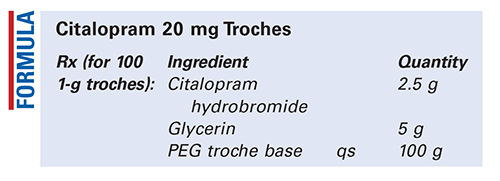US Pharm. 2019;44(11):48-CV3.

Method of Preparation: Calculate the required quantity of each ingredient for the total amount to be prepared. Accurately weigh and/or measure each ingredient. Citalopram hydrobromide (HBr) 1.25 mg is equivalent to citalopram 1 mg. Melt the polyethylene glycol (PEG) troche base at 50°C to 55°C until just melted. Separately, mix the citalopram HBr powder with the glycerin to form a smooth paste. Add the mixture to the melted PEG troche base while mixing constantly. Cool the mixture slightly and pour it into molds. Package and label.
Use: This preparation is indicated for the treatment of depression.1
Packaging: Package in tight, light-resistant containers.
Labeling: Keep out of reach of children. Use only as directed. Discard after ____ [time period].
Stability: A beyond-use date of up to 6 months has been used for this preparation.2
Quality Control: Quality-control assessment can include weight, specific gravity, active drug assay, color, texture of surface, appearance, feel, melting test, dissolution test, physical observation, and physical stability.3
Description: Citalopram HBr (Celexa, C20H22BrFN2O, MW 405.35) is an orally administered selective serotonin reuptake inhibitor (SSRI) with a chemical structure that is unrelated to other SSRIs or to tricyclic, tetracyclic, or other available antidepressant agents. It occurs as a fine, white to off-white powder that is sparingly soluble in water and soluble in ethanol. Citalopram HBr is available only in tablet dosage form. Celexa 10-mg tablets are film-coated, oval tablets containing citalopram HBr in strengths equivalent to 10 mg citalopram base. Celexa 20-mg and 40-mg tablets are film-coated, oval, scored tablets containing citalopram HBr in strengths equivalent to 20-mg or 40-mg citalopram base. The tablets also contain the following inactive ingredients: copolyvidone, cornstarch, croscarmellose sodium, glycerin, lactose monohydrate, magnesium stearate, hypromellose, microcrystalline cellulose, PEG, and titanium dioxide. Iron oxides are used as coloring agents in the beige (10-mg) and pink (20-mg) tablets. Celexa should be administered once daily in the morning or evening, and with or without food.1
Glycerin (glycerol, 1,2,3-propane triol) occurs as a clear, colorless, odorless, viscous, hygroscopic liquid with a sweet taste about two-thirds as sweet as sucrose. It has a specific gravity of about 1.25. Glycerin is miscible with water, methanol, and 95% ethanol; it is practically insoluble in oils and chloroform and slightly soluble in acetone. Glycerin is hygroscopic and should be stored in airtight containers in a cool place. It is not prone to oxidation but will decompose on heating. When glycerin is mixed with water, ethanol, and propylene glycol, the mixtures are chemically stable. Incompatibilities with glycerin include strong oxidizing agents, such as chromium trioxide, potassium chlorate, and potassium permanganate, which could cause it to explode. When glycerin is mixed with zinc oxide or basic bismuth nitrate and exposed to light, it will form a black discoloration. When glycerin is mixed with phenols, salicylates, or tannin, a darkening of the mixtures may occur owing to an iron contaminant in the glycerin. Glycerin will form a strong acid complex (glyceroboric acid) when mixed with boric acid.4
PEG troche base is available from a number of vendors. Freedom PEG Troche Base is a buccal/sublingual vehicle that is preblended with PEG, binders, suspending agents, sweeteners, and flavor enhancers. Medisca Troche Base, a sweetened blend of PEGs, is used to compound medicinal lozenges and troches; it occurs as small, white, translucent pieces at room temperature and is meltable at between 45°C and 51°C. Humco lists a Humco PEG Troche Base, and Letco Medical offers a PEG-based, sugar-free troche base. Techna 20 SF Troche Base with Bitter-Bloc is a sugar-free (naturally sweetened with stevia) PEG formula base with a soft mouthfeel that includes natural suspending agents as well as other natural flavor enhancers. Techna 20 SF is an easy-to-use, granular, traditional troche base with an ideal melting temperature of 42°C to 46°C; it comes ready for the addition of actives, flavors, and colors. PCCA (Professional Compounding Centers of America) offers NataTroche troche base, which masks bitter tastes and does not require additional suspending or dispersing agents; its consistency is like that of chocolate.
REFERENCES
1. RxList. Celexa. www.rxlist.com/celexa-drug.htm. Accessed October 2, 2019.
2. U.S. Pharmacopeia/National Formulary [current revision]. Rockville, MD: U.S. Pharmacopeial Convention, Inc; October 2019.
3. Allen LV Jr. Summary of quality-control testing for sterile and nonsterile compounded preparations, part 1: physical and chemical testing. IJPC. 2019;23(3):211-216.
4. Alvarez-Nunez FA, Daurio D. Glycerin. In: Sheskey PJ, Cook WG, Cable CG, eds. Handbook of Pharmaceutical Excipients. 8th ed. London, England: Pharmaceutical Press; 2017:401-405.
To comment on this article, contact rdavidson@uspharmacist.com.





